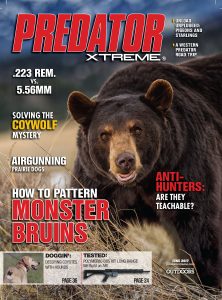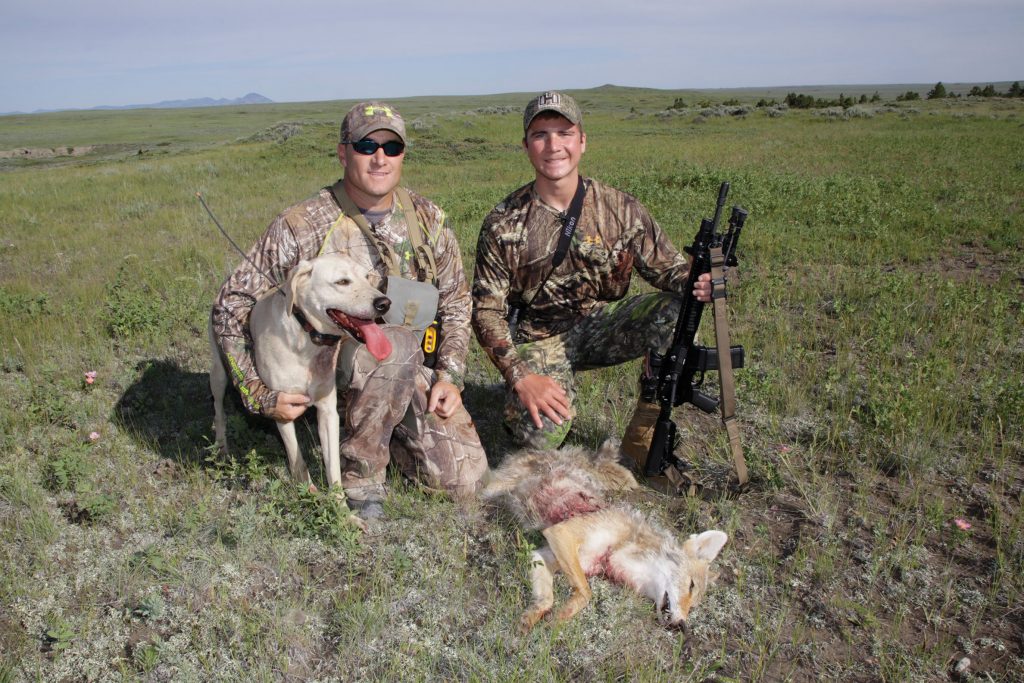“More fun than should be legal.” That’s how Montana native Levi Johnson defines hunting coyotes with dogs. Johnson readily admits he wasn’t the first discover the effectiveness of using decoy dogs to lure in spring and summer coyotes. It’s been used for decades by animal damage control experts and coyote fanatics alike. Johnson just lives and breathes the intensity of the decoy action while hunting behind his dogs. It’s more than a sport. It’s his lifestyle.
Johnson caught the bug after borrowing a buddy’s videotape on decoying coyotes with dogs, produced by E.L.K. Inc. After watching it, he was hooked. He went back to his buddy, Destry Harris, and acquired a couple dogs. That was in 2007. Today he has three working dogs, white mountain curs and is adding another newbie to the group soon to replace older hunting partners.
An Opposing View
Traditional trappers and predator hunters often take an opposing view to the sport of spring and summer coyote hunting. They argue that fur goes to waste thus giving pro-predator groups more fodder for the debate on eliminating all predator control. Johnson realizes that simple fact, but he knows his efforts also have an economic impact, which goes beyond fur coats. By reducing the coyote population in conjunction with other means such as aerial hunting, he helps decrease livestock losses for local ranchers.
He also helps sportsmen and small-town economic impact. Coyotes may be rodent raiders most of the year, but as soon as fawns, deer and pronghorn hit the ground, coyotes shun small game and place fawns at the top of the menu. Of course fawns later add to the big-game population for hunters to pursue. Those hunters visit rural outbacks of Montana and hot hunting locales coast to coast. They spend dollars on fuel, food, lodging and outfitting. If big-game numbers decline, then so does the number of hunters visiting these areas. That means an instant drop in economic impact to areas that can use every dollar available in a questionable economy.
Coyotes have increasingly been affecting deer and other game densities across the nation. Once upon a time it was a western theme. Studies from Oklahoma, Texas and even urban centers show a clear trend for coyotes to change up the menu in summer. Most studies indicate that in the height of fawn season, specifically June and July, coyotes will almost exclusively dine on fawns with the percentage of their diet made up of fawns going as high as 70 percent.
It’s now become an East Coast theme as well. In South Carolina, coyotes were first documented in 1978 and were thought to be linked to animals that were illegally imported for hunting purposes. Studies from the U.S. Forest Service Southern Research Station at the Savannah River Site clearly show that coyotes are preying on whitetails in a big way. Data derived from research indicates approximately 70 percent total fawn mortality. Coyotes were responsible for approximately 80 percent of these mortalities. That premise is increasing east of the Mississippi River in other locations as well.
The Case For Canines
Randy Roede has been working as a wildlife damage specialist for the South Dakota Game, Fish and Parks for the past 14 years. His predator hunting experience dates back more than four decades and for the past two decades his coyote-hunting partners have been decoy dogs. His work objective is to minimize all animal damage which takes in predator control. He’s no stranger to the fact that fawns, both deer and pronghorn, have been rising in priority on the coyote dining list for the past five or more years. He believes this is due to the average age of coyotes is increasing and once a coyote has discovered a food source, like fawns, they remember that for future hunting opportunities.
RELATED: Video: Summer Dogs Equal Hot Coyote Action
When it comes to spring coyote work it’s all about two things for Roede: locating coyotes and using their behavior to his benefit. While scouting, he listens for vocal cues of coyote activity in an area and then he looks for water.
“Once a breeding pair puts in a den, the majority of den sites are within a quarter mile of a water source. It’s almost 100 percent,” says Roede. “After the pups are born, the female stays in the hole for up to the first week, but after eight to 10 weeks the pups will be weaned and move loosely around the hole.”
According to Roede, pups are forced to hunt for themselves soon after the weaning period and he rarely sees a fat pup, especially if the coyotes are living in wide open spaces with prey spread sparsely. Throughout this period and through the end of summer, the adult pair, and babysitters, guard the area to protect the pups that have an ever-increasing, adventuresome nature. Roede clarifies that the best time for decoy work is the months between Memorial Day and Labor Day. This is when his decoy work gets serious and his job extends beyond the initial decoy event.
“For me, decoying coyotes is work. It’s not recreational. I’m trying to get all the adults, including the wet female. Decoying works for this part of the job, but then I move on to the den and smoke it to kill the orphan pups,” notes Roede. “If you follow through and take the dens out you can be very effective in the right country. But if you don’t have a year-round plan to trap and snare in the winter, do aerial hunting and do den work, you’ll get behind the eight ball.”
Johnson follows a similar pattern of hunting the warm-weather months. Coyote parenting is a serious responsibility and the major downfall of coyotes when they encounter dogs. Here’s how Johnson breaks down a coyote’s summer mindset:
“What the coyote is thinking, regardless if it is a single, a pair or even three or four coyotes, is that they have laid claim to an area. It’s the territory they use to raise and feed their young,” says Johnson. “The dogs bring a visual and when you run the lone howls, yips, rabbit distress and pup screams, it’s sending a message that an intruder has come into the area to take it over, or at the very least disrupt things.”
This triggers coyotes to engage their maternal and territorial instincts. They feel compelled to survey the perceived chaos and act accordingly to defend territory and pups. In fact, it’s the dogs that really separate a summer- and winter-calling setup. Nearly all of the calls that Johnson utilizes on a setup mimic the standard sequence callers use on wintertime setups.
“I don’t change it up a lot. It’s more about knowing where coyotes live and scouting to find those areas,” says Johnson. “I always use lone howls to start. It says I’m in the area and asks if anyone is out there, or claimed the area. Then I go to the lunch box and rabbit in distress. It makes coyotes mad that someone is in their refrigerator. They may come to that call as well or simply peek over the ridge to look for the invader. If they don’t come, I move to the third call. It’s the sounds of a hurt coyote and I also use pup in distress. This is like someone attacking your family or kids. They’ve had enough by then and usually come right in.”
Are you beginning to get the itch to use dogs for decoying purposes? Johnson doesn’t discourage anyone from the activity, but he does emphasize that it’s a bit more of a responsibility than acquiring a new schnauzer as a family pet.
“It’s much more than getting a family dog. I have countless and countless hours of training and money into these dogs, including feeding and housing them,” notes Johnson. “You also have to be able to understand your dogs in a split second. You need to know what’s going on with your dogs or you could shoot one accidentally in the rush or it could get hurt in the coyote encounter.”
If someone calls Johnson he freely shares information and he doesn’t recommend one breed over another, or even running multiple dogs on a setup. According to him, any breed and any sex will work. You just need to get the dog out and hunt them.
“As hunters we learn something new every time we go out. It’s the same for your dog. You have to get them out in the field and train them. They pick it up quickly. My dogs know the drill and know what to do. In fact, my new dog Maggie has been easier to train than ever. She picks up hunting from my 8- and 9-year-old dogs. It takes a lot of pressure off me. Nevertheless, lots of time goes into it so be ready for a commitment.”
Johnson also emphasizes that you should look for a medium-sized breed. As noted earlier, he prefers mountain curs, as do many coyote decoy enthusiasts and offers these characteristics when picking a winner.
“It’s rare for your dog to get injured. Coyotes want your dog to leave so they run up and try to hamstring them with quick nips. But that doesn’t mean you should go with a big dog. They will play out on you in hot, summer weather. And a little dog may be too hidden in the sage or cover for a coyote to acquire a visual on them. I prefer a medium-sized dog. They offer the best of all worlds for decoying.”
If you ever get a chance to experience a spring or summer coyote hunt with experienced dogs, it’s an event you’ll never forget. This past summer my 18-year-old son Cole and I spent a few days with Johnson in central Montana. On the very first set, Johnson called and decoyed in three coyotes. Unfortunately, a herd of yearling heifers rushed the set and blew the coyotes out of the country.
We moved to a second location and after howling to confirm the coyotes were home, Johnson went to work. Within minutes, two coyotes rushed off a far ridge to engage Johnson’s two dogs, Dezi and Copper. After initial teasing, the dogs pulled the coyote pair to within shooting range. Cole tipped over the first coyote to clear the dogs and then it got Western!
The dogs view a downed coyote as a reward and sprinted to tear into it. At the same time, the second coyote lunged to protect its partner. This nipping in and out dance continued for a few minutes before Cole finally found a clear shooting lane and ended the unruliness.
On the third setup, Johnson’s dogs decoyed in another single for Cole and at day’s end Cole was awarded his first triple.
Johnson describes it this way and you can’t argue the fact after a day in the field with him. “It’s the most effective way to hunt coyotes outside of using a plane or a helicopter.”








